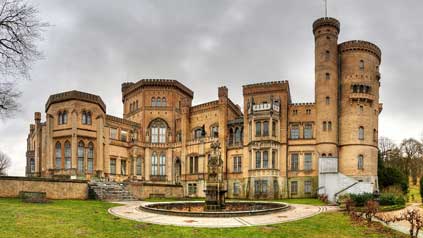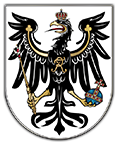
Situated on the picturesque banks of the River Havel is Schloss Babelsberg (Babelsberg Palace), part of a collection of palaces and parks in Potsdam that have been recognised as a UNESCO World Heritage Site since 1990. The palace is named for the Babelsberg quarter and includes an adjoining palace garden.
Babelsberg Palace was built in 1833 at the request of Prince William Frederick Ludwig of Prussia (1797-1888), later Emperor William I, and his wife Augusta of Saxe-Weimar-Eisenach (1811-90). Built as a joint summer residence, the palace stood in stark contrast to other buildings in the capital. Prince William commissioned famed architect Karl Friedrich Schinkel (1781-1841) to design and build the palace. Schinkel has also designed the nearby Glienicke Palace and the Konzerthaus am Gendarmenmarkt in Berlin, among other things.Modelled after largely British designs and particularly influenced by the Tudor style designs, Babelsberg Palace was built in a Gothic Revival style. After the death of Schinkel, the construction of the palace was overseen by Johann Heinrich Strack and Ludwig Persius. The two-storey building includes private rooms for William and Augusta, as well as a number of outbuildings. The interior also features a hall-like dining room, an octagonal ballroom with a starry sky, and rooms for the royal couple’s children. The palace’s design incorporated castle elements, including battlements, pointed arches and other features. The interior is decorated in a neo-Gothic style, and many rooms are preserved in their original state.
On 22 September 1862, Babelsberg Palace hosted crucial talks between King William I and Otto von Bismarck. Following the meeting, Bismarck was appointed Prussia’s prime minister and foreign minister. After William’s death, interest in Babelsberg Palace subsided as his successors opted to live in other castles in the Potsdam area. After the Second World War, Babelsberg Palace housed the School for Film and Television and the temporary home of a pre- and early history museum.The palace is located within the 124-acre Babelsberg Park, which laid out during the 1840s. The park was designed as an English-style garden by Peter Joseph Lenné and later famous landscape gardener Ludwig Hermann Fürst von Pückler-Muskau. Babelsberg Palace and Park form part of a collection of parks and gardens that stretches from Sanssouci Palace in Potsdam to Peacock Island in Berlin. Visitors to the palace should not miss a walk in the park, which features carefully landscaped paths leading to various viewpoints such as the Fürstenhöhe or Viktoria points with wonderful views of the River Havel, lakes and Potsdam. The park is also home to several attractions including the Pleasure Ground and Golden Rose Stairs, the Victory Column, and to Flatowturm (Flatow Tower).
Events in Potsdam
ticket sales
Music Festival in PotsdamThe Music Festival in Potsdam will be held again in June. This year's theme "Music and gardens" ubiquitous. So even on the opening day in June. Interesting and unique you can take guided tours and visits to many different places. For those interested there is an Opera Workshop.
TICKETSDetails about the Music Festival in Potsdam can be found here.
The concert on the eve and Night of the Palaces in PotsdamThe Park of Sanssouci and Sanssouci Palace with its terraced vineyards and the New Palace are undisputedly the most important monuments in Potsdam, therefore provides the Night of the Palaces as an excellent temporal orientation, to learn more about the state capital of Brandenburg.
TICKETSDetails about the Night of the Palaces can be found here.



